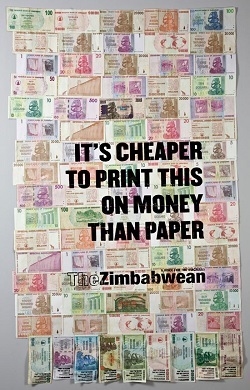5 Nightmare Realities When Your Money Is Suddenly Worthless

Between 2007 and 2009, Zimbabwe experienced a terrible bout of hyperinflation. While it might sound like the new original movie from the SyFy channel, hyperinflation is serious business -- people were literally sweeping worthless money off the street like roadkill. We spoke to a few folks who witnessed the rise and dramatic fall of the Zimbabwe dollar. They told us ...
Prices Can Change Numerous Times In Just a Few Hours

The hyperinflation began with the government printing more money to pay off crushing national debt, a war with the Congo and bad crops. Zimbabwe president Robert Mugabe had announced that all white-owned land would be given back to the black majority. The problem was that the land was given to inexperienced farmers, and Mugabe wanted the whites out so badly that there was no transition time for teaching new farmers how to ... farm. So more and more farms failed, raising prices, and rapidly inflating the Zimbabwe dollar.

"Fuck, cows look way different in person. How do I even milk this thing?"
When inflation first started creeping up in the mid-2000s, nobody really seemed to care all that much. Currencies, especially in Africa, fluctuated all the time. But after several years of worsening crops, the dollar in Zimbabwe plummeted. The government's solution was just to print more money -- this shit's just paper, anyway, right? No big deal. By 2008, prices of simple goods were changing daily -- sometimes even more often. Piet, a border driver, was in Zimbabwe when the inflation began to hit its hardest.
"That August I had more people than usual wanting to go into South Africa, so I made many trips a day back and forth," says Piet. "In the morning, a bottle of Coke at a store would cost only a few hundred million (Zimbabwe) dollars. When I got back in the afternoon another 50 million had suddenly been tacked on the price. And by evening on my third time around, there was another hundred million to the price. It had nearly doubled in 12 hours."
And this went on every day for several months. By October, that bottle of Coke cost trillions. With a T.

But returning the bottle still only netted you a nickel.
It really messed with people's daily routines:
"Some people going to the market brought a basket full of money, but were told they didn't have enough. They went back home and got enough, only to find that by the time they got back the price had changed again. Some people got out of lines because of announced price changes," Piet remembers.

"I just want some bananas. Come on, what's a few billion between friends?"
Zimbabwe then solved the currency problem once and for all: by getting rid of currency altogether. There was no more official currency of Zimbabwe. The Zimbabwe dollar was gone.
Zimbabwe Dollars Were Repurposed For Ridiculous Things
Even before being dropped as currency, the Zimbabwe dollar had virtually no value. A bundle of trillion-dollar notes could only buy a quarter-loaf of bread. And then there was toilet paper:
"The WC at the gas station across the border could not afford toilet paper, and buying it would require bundles of dollars for even one roll. When I had to use one there was a metal bin full of Zimbabwe dollars for only a few billion each. We had to literally wipe ourselves with billions of dollars."

"Quit wasting time making it different colors; they're all going to be brown in the end."
The plumbing couldn't handle all the money people were literally flushing down the toilet. They put signs up to stop people from clogging up their pipes with trillions of dollars. You remember how to spell "trillions" from earlier, right? It's with a T.

It's the only place that would ever turn down the business of a septillionaire.
Advertisements on normal paper became way too expensive, so bills were stuck together to make a large canvas, and the message was then printed on that collage. Most of the time it was advertisements, but it could also be used to make a statement:

They would've drawn dicks on all of them, but the Sharpie was too valuable.
Society Becomes Barter-Driven

The country now had no paper currency, little hard currency such as gold or silver, a law forbidding foreign currency, and a population that still needed to make purchases. Yep, welcome to Bartertown.
Zack visited Zimbabwe during this episode of hyperinflation:
"Almost the literal second I crossed the border, my group was followed by a small crowd of people trying to sell things. Many of them didn't have shirts, and they looked like xylophones. Using American dollars or the South African rand was totally illegal, but everyone seemed to have pretty much stopped caring at all about the law. We found a bank and I figured I could exchange American dollars for Zimbabwe dollars and become an instant, pointless millionaire for shits and giggles, but the bank didn't actually use Zimbabwe dollars. In fact, the economy was so thoroughly reduced to barter and black markets in the area near Victoria Falls that I never even saw a Zimbabwe dollar in Zimbabwe."

Children eagerly awaited the Tooth Fairy leaving a goat under their pillow.
As Zack continues, "Hyperinflation creates massive shortages of basic consumer goods because if you sell something, you basically get paid with monopoly money, so it is better to just hang onto whatever it is you have. One could literally have a quadrillion dollars in cash and still not be able to get a basic necessity, such as pens, because they simply didn't exist in that county. When we wanted to buy something, merchants would haggle for our shoes, backpacks, and pretty much everything else on us before haggling for American dollars. Luckily we had a bunch of simple ballpoint pens on us, so they wound up taking piles of pens instead of American dollars. For a moment, pens were the local currency. They needed pens, and we had pens, and those were all the pens in the world as far as they were concerned."

We weren't joking about the Sharpie thing.
It got to the point that even freaking health care was bartered (literally setting broken arms for peanuts). Eventually when a currency was reinstated, people still kept the barter system going ... because the last time they trusted paper, they ended up wiping their asses with their life savings.
The Black Market Becomes The Most Legitimate Market

Because all the marketplaces and businesses were now functioning through barters and haggling, the old rules no longer applied. For example, take the guy who had been snapping up and stockpiling shirts and only traded them for things he needed. Shirts were so rare that he could charge whatever he wanted for them, and he took full advantage of his monopoly on nipple coverings. In order to keep prices stable, there has to be competition. Lucky for everyday people, there was a friendly neighborhood black market.
"All the merchants and traders hated the black market, and not just because of their questionable legality," recalls Piet. "The black market had everything, so they became the competition to those who otherwise had complete control of the market. One black market guy on the border from Victoria Falls would always come on a Wednesday. He had all the electronics and appliances (DVD players, iPods, toasters). In the town, there were a bunch of traders who sold these for severely high markups. One guy sold his car to one of the 'legitimate' traders for a satellite dish because he wanted to see the 2008 Olympics.

The only bigger waste of money than the trillions in his wastebasket.
Here comes the black market guy to save the day! He also had a few dishes (thanks illegal cable!). Everyone wanted to see a swimmer named Kirsty Coventry, and since many people had TVs but no way of getting signals all the way from Harare, satellite dishes were the only way."

That medal fetched her half a bag of semi-digested Skittles.
The black market guy sold them for about a quarter of what the trader was asking. This forced the store to lower its prices to slightly less than "a whole friggin' car" to compete.
You Suddenly Get Freedoms You'd Never Dreamed Of Having

The Zimbabwean government didn't want to just give up on money and make "whatever you got on ya" the official national currency. So President Mugabe had to swallow his pride and drop the long-standing law that had forbidden the exchange of foreign currency.
"I had always brought money with me going up. That was always worrisome, as I could be robbed," says Piet. "But once foreign currency was lifted, I could now bring U.S. dollars and euros in to buy food and gas. For a while it was only the white community and tourists bringing it in, but once the government abolished the rule banning money transfers, all the bartering stopped."

Doctors still worked for peanuts though, because Mugabe was still an asshole.
When these laws about foreign currency were suddenly dropped, people realized that the government could, in fact, do their jobs if you really, really pushed them to. The people pushed. In 2014, Zimbabwe's highest court rescinded the prohibition on publishing "false statements." (In the past, the government had defined "false statements" as "anything they didn't like.")
Even Mugabe was forced to share power. In 2009, Zimbabwe elected its first prime minister since 1987. All of this stemmed from laws enacted to help fight hyperinflation. Sadly, the position was abolished after the economy stabilized, similar to how Germany consolidated and centralized leadership in the 1930s. You know what they say: "Mo' money, 'mo problems."

Or perhaps more accurately, "some money, mo' problems."
Regardless, Zimbabwe is now on the long road to recovery. Its people are just the latest in a long line to learn the awful truth: Hyperinflation sucks for everyone ... except the guy with a shirt monopoly. He doesn't have it quite so bad.
Evan V. Symon is the interview finder guy for Cracked. Have an awesome job or experience? Hit us up at tips@cracked.com.
Zachary Frey is going to be a freshman at Cornell University this August. He also writes for Cracked on a regular basis. You can (and should) read some of his other awesome articles here.
For more insider perspectives, check out 6 Insane Things You Learn Overthrowing Your Own Government and I Was Transgender And Didn't Know It: 6 Weird Realities.
Be sure to follow us on Facebook and YouTube, where you can catch all our video content such as 5 People Who Are Way Too Good At Crappy Jobs and other videos you won't see on the site!
Have a story to share with Cracked? Email us here.

